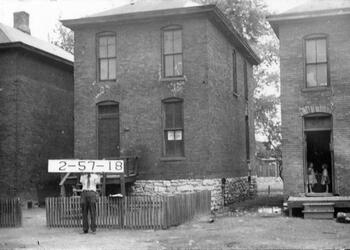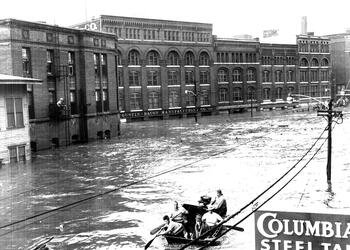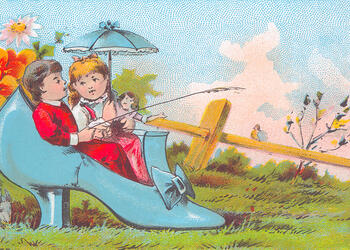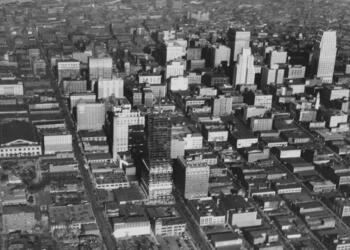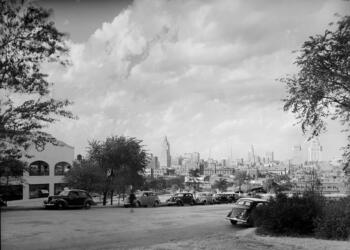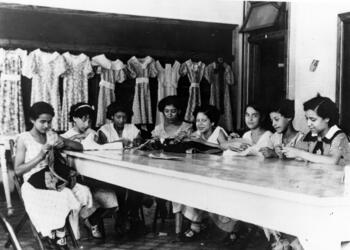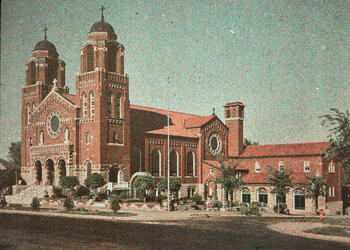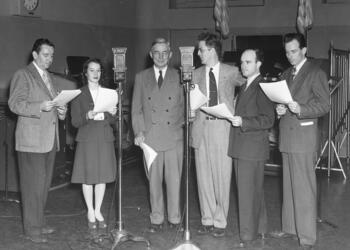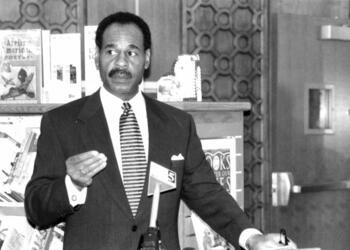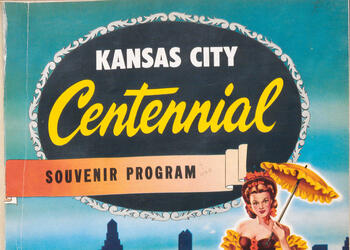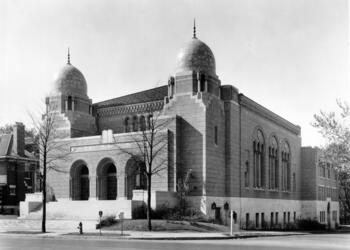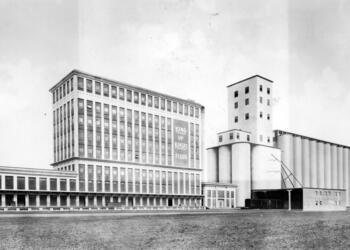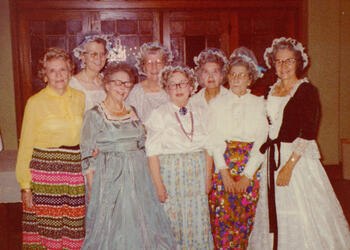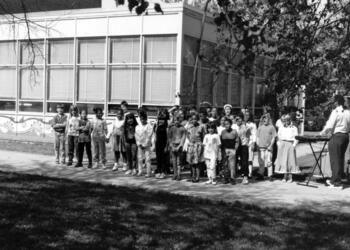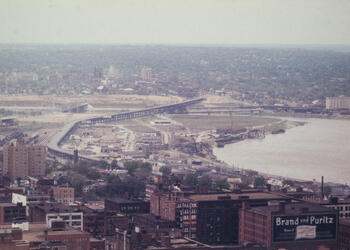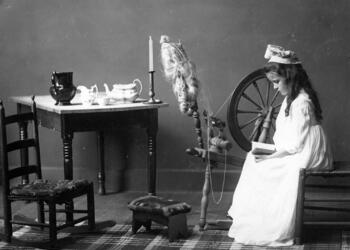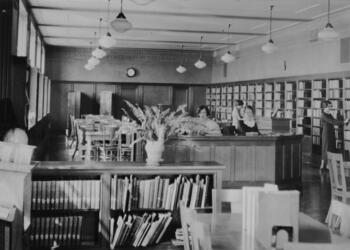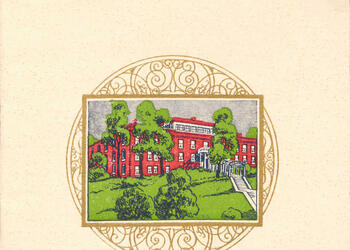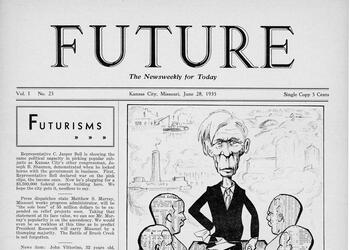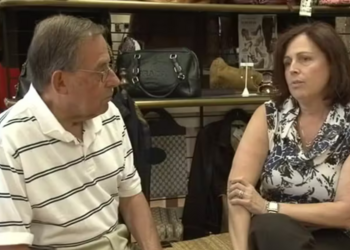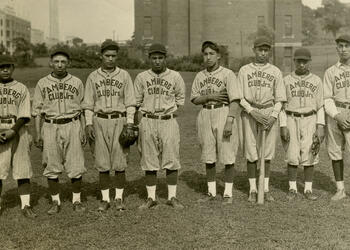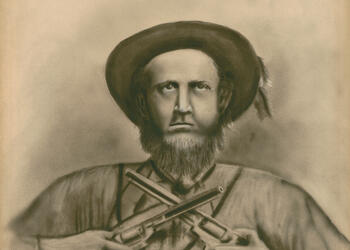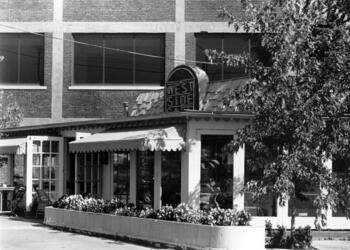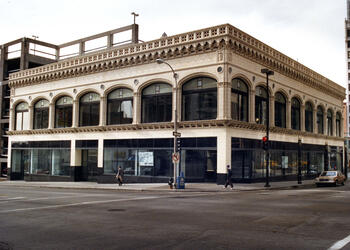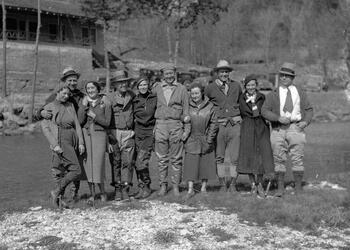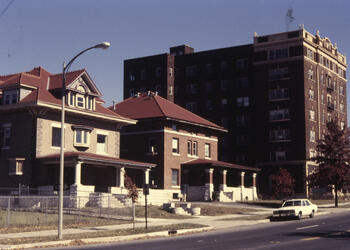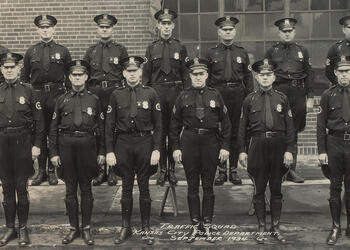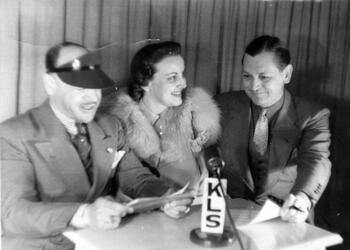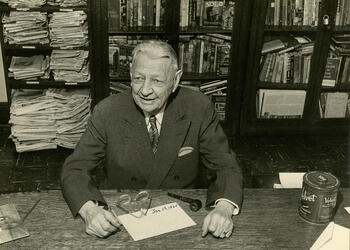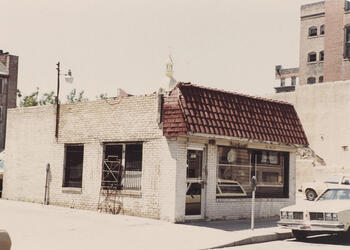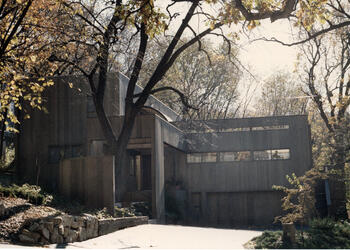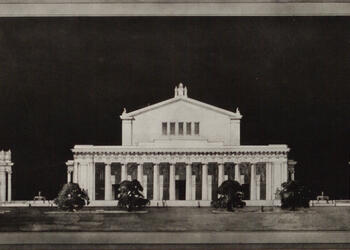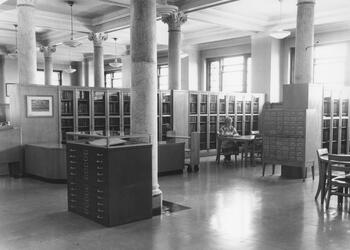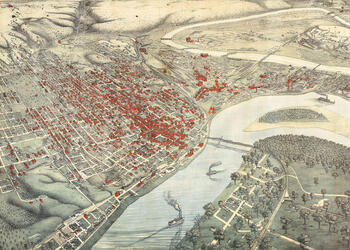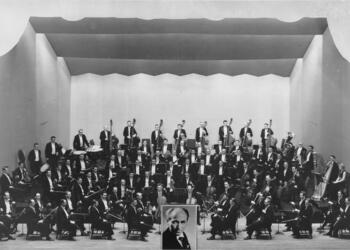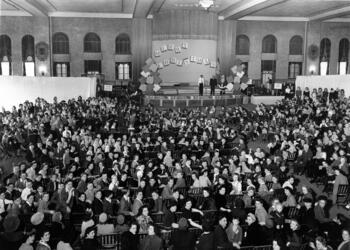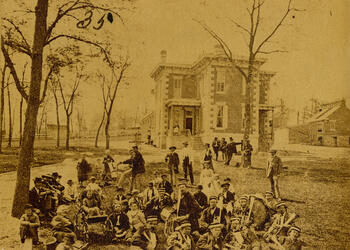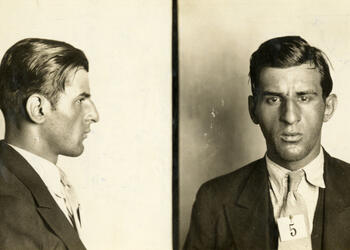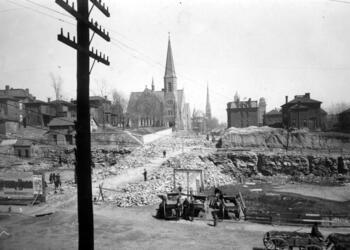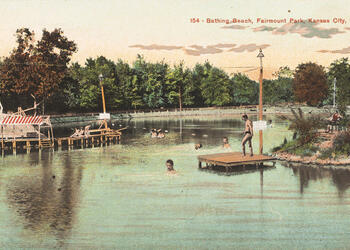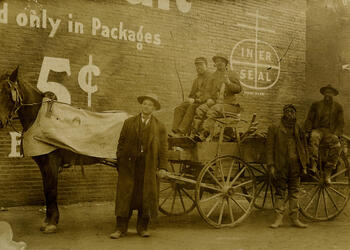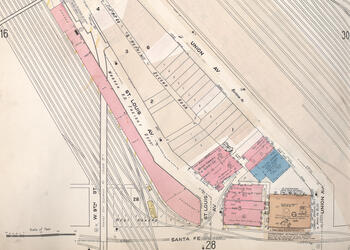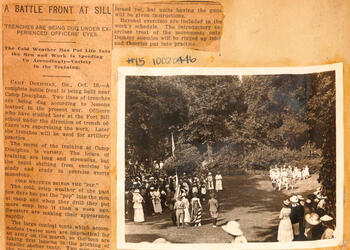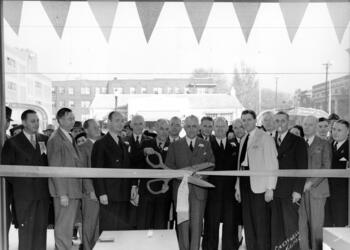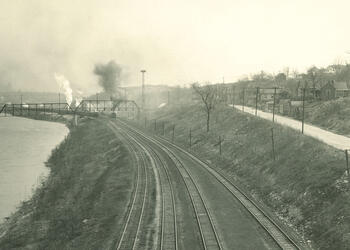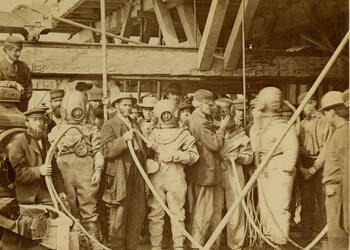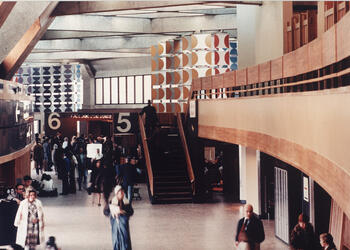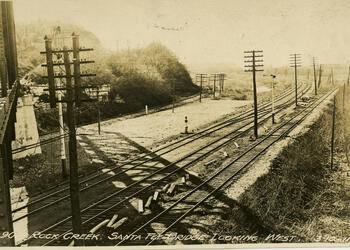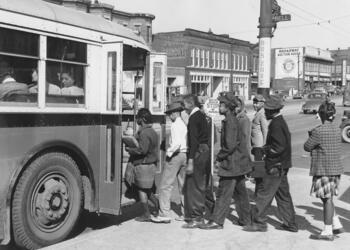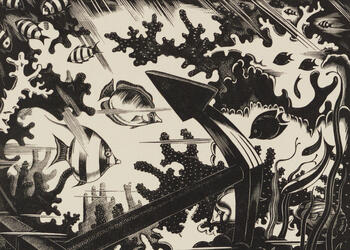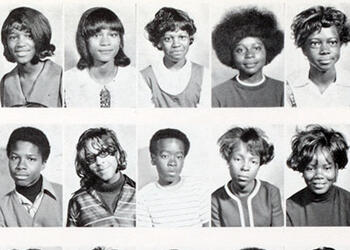Digital Collections
A photographic survey of all standing buildings in Kansas City, Missouri including many structures that are no longer in existence or would not have otherwise been photographed. Accessible at KC1940.org.
The 1951 flood was one of the most devastating natural events in the Kansas City area. The photographer of these 30 images is unknown. Numerous other photographs of the 1951 flood can be found by putting 1951 Flood in the search box or…
This collection consists of the organizational records for ACT/UP (AIDS Coalition to Unleash Power), Kansas City, Missouri, chapter. The years covered include 1987, a year before the group was formed, to 1995 when the group disbanded. ACT-…
Victorian trade cards, one of the more picturesque collections in the Missouri Valley Room, provide not only a rich resource for researching the history of printing, advertising, medicine, fashions, late nineteenth-century culture, etc.,…
Curtiss-Wright Flying Service, Photo Division New York City, shot these Kansas City aerial views in the 1920s and '30s. The company's name derived in 1929 from pioneer aircraft engine developer and manufacturer Glenn Curtiss and…
Local photographer Robert G. Askren donated photographs and negatives to the Missouri Valley Special Collections in 2006. Images generally depict Kansas City buildings, parks, streets, important events, local personalities, and aerial…
This eclectic collection consists of images of people and Kansas City places including schools, ice houses, hospitals, street scenes, historical monuments, and more.
During the early 1930s Frank Lauder employed the autochrome process to photograph homes, gardens, and landmarks throughout the Kansas City metropolitan area. These 1400 unique color images provide a truly captivating and one-of-a-kind view…
The famous - and infamous - and not so famous but important Kansas Citians are featured in these locally written biographies. Actors and actresses, artists and architects, politicians and philanthropists, sports figures and settlers,…
The Black Archives of Mid-America Oral History Collection is comprised of 56 interviews of prominent citizens and community leaders documenting the Black experience in Kansas City. The interviews were captured in 1975 and 1976. All of the…
A collection of digitized historical books about Kansas City history. Highlights include a souvenir program book for the 1950 Kansas City centennial, a Superbowl IV promotional booklet from 1970, and a city directory of Kansas City's…
Kansas City can boast its fair share of architecturally significant buildings. This digital collection highlights 26 of these and includes the historic Vaughan Diamond Building commonly called The Junction (featured here on the left), the…
In 1926-1928 Henry D. Green created a scrapbook with 78 images that feature business buildings, banks, hotels, and theaters.
Comprised primarily of photographs from Olive Hoggins' Centenary History of the Churches and the Westminster Congregational Church Records, this collection highlights many of Kansas City's churches, their activities, and their…
Joe Sanders and Carleton Coon co-founded the Coon-Sanders Nighthawks orchestra that gained fame during the 1920s. This digital collection includes many photographs of the orchestra and other performers as well as photographs from Fred…
Kansas City schools and school children comprise the bulk of this grouping of over 470 images. Included are the following special collections: Nikoles Aleshi/Virtuana System; James A. Hazlett; Kansas City, Mo. School District; James F.…
During the 1950s and 1960s, amateur photographer Dorothea Eldridge took slides of Kansas City scenes which include buildings, hospitals, riverfront areas, Municipal Airport, Union Station, the West Bottoms, and more. Of the 108 color…
In addition to photographs, this group has images of documents such as letters. Included are the following special collections: James J. Akard (Civil War related papers); Carl Betz; Jim Bridger; Dixon/Jordan Family; Leonard/Guitar Family;…
Finding aids provide information about processed collections in the Missouri Valley Room to help researchers understand what materials are available. A finding aid will provide an overview of the collection and an inventory of boxes and…
This collection contains items relating to the Willows Maternity Home, which operated at 2929 Main Street from 1905 to1969. The institution served as an adoption service and private, temporary home for unwed mothers. It contains materials…
Issues of Future, an anti-corruption weekly periodical published in Kansas City. From the first issue: "It will discuss the news, local, state, national, foreign, endeavoring to express the facts as it seems them ... As a newsweekly,…
This collection contains DVDs and transcripts that were created as part of a Kansas City Garment Industry History Project. The collection consists of oral history interviews and supplemental audiovisual materials related to the Garment…
The Guadalupe Center began in 1919 when the Agnes Ward Amberg Club for Women established a settlement house primarily for Mexican immigrants. This digital collection of over 550 photographs originally was in three photo albums. Views…
This digital collection consists of 52 charcoal portraits created by artists Anna Lee (Dillenbeck) Stacey and Elmer Stewart. Unfortunately, the provenance for the drawings is unknown. A 1992 library office memo indicates they came to the…
The Judge Elmo M. Hargrave Photograph Collection contains images taken circa 1920s-1940s that were used to document accident sites in the city. They provide a unique perspective on the traditional views of streetscapes, businesses,…
The Hispanic Oral History Collection was created by librarian Irene H. Ruiz while working at the West Branch of the Kansas City Public Library. The 59 interviews she collected in the 1970s-1980s document the experiences of longtime west…
The Historic Kansas City Foundation is a nonprofit organization that advocates for the preservation and rehabilitation of historic buildings, landscapes, and neighborhoods in Kansas City. This collection contains images documenting the…
The Kansas City Journal-Post came into existence in 1928 when the Kansas City Journal and the Kansas City Post merged. The paper ceased publication in the 1940s, at which time they apparently sold various items. In 1998 Richard Zeldin…
Photographic slide collection from the Kansas City Landmarks Office. Images depict the built environment of Kansas City from the late 1970s to the early 1990s.
The Kansas City Police Historical Society Collection consists of scrapbooks, reports, correspondence, ephemera, and photographs relating to the Kansas City Police Department. The Hugh M. Dougherty Scrapbook #1 has been digitized and can be…
The five oral histories in this collection were created as a pilot project which was to serve as the model for a larger Kansas City Regional History Project. The project was funded by a 1988 Presidential Grant awarded by Rockhurst…
The photographs in this collection come from a portion of The Kansas City Star’s records donated to Missouri Valley Special Collections in 2018. Most are from the research files of former Kansas City Star and Times editor and author Monroe…
The Landmarks 2020 Addition sub-collection documents the Kansas City built environment from the 1940s to the 1980s.
Kansas City Landmarks Commission donated nearly 1,000 photographs to the Missouri Valley Special Collections. They are divided into four groups, but only three have images in the MVSC Digital Gallery: Health Care; Art Commission Awards;…
In 1921, the Liberty Memorial Association held a contest to determine the design of the memorial. Eleven proposals from local and national architectural firms were submitted. The design by New York architect Harold Van Buren Magonigle was…
This resource is an index to numerous articles in magazines, newsletters, newspapers, books, as well as factual entries on topics of interest, with nearly 40,000 records. More entries are added daily by librarians. To view most of these…
Digital images include state, county, and city maps as well as road, railroad, river, and other areas like the trails. Due to copyright restrictions, many of the records in this collection do not have an associated image. These may be…
Portrait and group shots of musicians, dancers, and actors comprise this digital collection. The following special collections are included: Dory DeAngelo; Charles Johnson; Felice Lyne; Miracle Scrapbook; Helen Seibert Thomes; Youth…
This artificial collection of 146 photographic images, circa late 1880s to the early 1900s, includes scenes of Native American peoples in Indian Territory, Oklahoma, "Boomer" settlers and settlements, and scenes from the 1890…
When Nell Quinlan married Paul Donnelly and moved to Kansas City from Parsons, Kansas, in 1906, she wanted to keep costs low, but still look stylish while working around the house. Not finding what she wanted, she designed and sewed her…
These late nineteenth-cenutry images of early Kansas City, primarily the 1870s-1890s, provide unique views such as the Board of Trade building under construction, exterior and interior views of the glass Exposition Building, unusual…
This collection contains files relating to organized crime in Kansas City from the 1930s to the 1970s.Contents include records from the Kansas City Police Department and Federal Bureau of Investigation, reporter’s notes, newspaper…
Brookings Montgomery was a local photographer who owned and operated Montgomery Foto Service for over 50 years during the twentieth century. His collection of thousands of photographs provided the beginning for the general photograph…
Mrs. Sam (Mildred) Ray's postcard collection contains over 16,000 postcards from all over the world. Only 700 of these have been digitized. For some years, Mrs. Ray wrote a weekly column for The Kansas City Star and The Kansas City…
The John Ramos Collection contains material related to Black history and culture with a special emphasis on the Kansas City area. The objects in this collection are from the Lincoln Branch Library vertical files as well as the broader…
This collection contains the work of Steve Lispi, a commercial artist who was especially active during the mid-20th century. Lispi designed advertisements, packaging, branding, and various promotional materials for numerous clients in…
The Kansas City Sanborn Fire Insurance maps consist of over 1200 individual pages or images. The large-scale maps provide an invaluable resource for historians, genealogists, geographers, students, environmentalists, and others researching…
The Kansas City Area School Newspapers collection represents the school newspapers published by the student bodies of Kansas City area schools and housed within Missouri Valley Special Collections.
A collection of scrapbooks created by Kansas City area clubs, organizations and individuals.
The South Central Business Association, organized in 1919, was a business group located in the area of 31st Street and Troost Avenues. The core of the collection contains 44 scrapbooks with newspaper clippings, photographs, brochures,…
This collection contains images that document the history of Saint Mary's Episcopal Church at 13th and Holmes in downtown Kansas City. The church was organized in the River Market area in 1857 under the name Saint Luke’s Mission. The…
The Kansas City Stockyards operated in the West Bottoms from 1871 to 1991. It was the second largest stockyards in the nation and one of Kansas City's most important industries. This collection documents the natural and built…
In 1870, engineers Octave Chanute and George Mason published their account of the building of the Hannibal Bridge, the first permanent rail crossing of the Missouri River. Their text covers every detail of the project from its initial…
This collection shows modes of transportation used around 1910: railroads, the newly evolving automobile, streetcars, interurban to Excelsior Springs, riverboats, and an early airplane. Few photos of rolling stock and engines appear, but…
The Union Station Construction Photographs collection consists of 49 photographs of Kansas City’s Union Station and corresponding infrastructure while under construction. The photos are identified, dated between 1910-1911, and offer…
Primarily from the 1940s-1950s, these 340 photographs contain shots of the city market, municipal auditorium, street scenes, city officials, aerial views, and parks. Willis Castle, was employed by Kansas City, Missouri, as Superintendent…
The Woodcut Society Collection contains 18 print folios commissioned by Alfred Fowler for the organization between 1932 and 1941. The majority of the prints are in black and white, but a few are in color. Each artist used a block to make…
The Kansas City Area Yearbooks Collection is comprised of over 1,000 digitized yearbooks. Each volume can be accessed as a text searchable PDF. While a large number represent the Kansas City School District, many others from suburban,…


